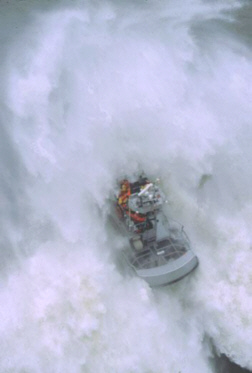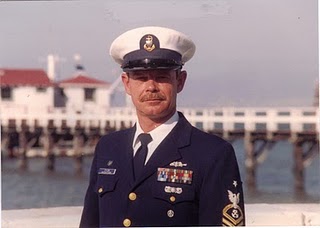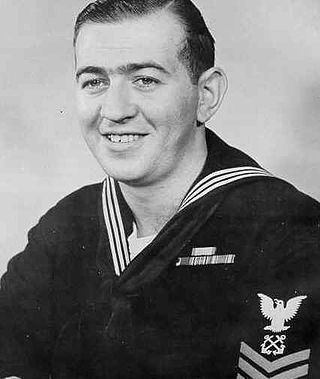
Tillamook Bay is a small inlet of the Pacific Ocean, approximately 6 mi (10 km) long and 2 mi (3 km) wide, on the northwest coast of the U.S. state of Oregon. It is located just north of Cape Meares in western Tillamook County approximately 75 mi (120 km) west of Portland.
The Surfman Badge is a military badge of the United States Coast Guard, issued to enlisted or officer personnel who qualify as Coxswains authorized to operate surf boats in heavy surf. Those so qualified are referred to as surfmen, a term that was originally used by the United States Life-Saving Service, one of the predecessors to the Coast Guard.

Barview is an unincorporated community in Tillamook County, Oregon, United States, named in 1884 by L. C. Smith for its exceptional view of the bar at the entrance to Tillamook Bay.

Klipsan Beach was the site of a station of the United States Life-Saving Service. The station buildings still remain, although they are privately owned. The station is on the National Register of Historic Places. The station's name was originally Ilwaco Beach, and only later became known as Klipsan Station. The station was one of several assigned to provide protection in the area known as the Graveyard of the Pacific.

Point Reyes Lifeboat Station, also known as Point Reyes Lifeboat Rescue Station, is a historic coastal rescue station, located on the Drake's Bay side of Point Reyes in northern California, United States. It was built in 1927 by the United States Lifesaving Service to replace a previous station dating from 1888. It is one of the best-preserved rescue stations of that period on the Pacific coast, retaining elements often lost, including the boat launching infrastructure. It is now a historic property managed by the National Park Service as part of Point Reyes National Seashore. It was listed on the National Register of Historic Places in 1985, and it was further declared a National Historic Landmark in 1989.

Coast Guard Motor Lifeboat CG-36500 is a historic, 36-foot lifeboat that is berthed at Rock Harbor in Orleans, Massachusetts. Built in 1946, it is notable for its involvement in the 1952 SS Pendleton rescue, one of the most daring such events recorded in the history of the United States Coast Guard. It was listed on the National Register of Historic Places in 2005, and now serves as a museum boat.
A rescue lifeboat is a boat rescue craft which is used to attend a vessel in distress, or its survivors, to rescue crew and passengers. It can be hand pulled, sail powered or powered by an engine. Lifeboats may be rigid, inflatable or rigid-inflatable combination-hulled vessels.

United States Coast Guard Station Cape Disappointment, situated near Cape Disappointment, Washington, at the mouth of the Columbia River, is the largest United States Coast Guard search and rescue station on the Northwest Coast, with 50 crewmembers assigned. Cape Disappointment Station is also the site of the oldest search and rescue station within the Thirteenth Coast Guard District. The station's Area of Responsibility reaches from Ocean Park on the Washington Coast south to Tillamook Head on the Oregon Coast.

The 30 foot surf rescue boat is a lifeboat that the United States Coast Guard has used in recent years. The 30' long boat is designated the surf rescue boat (SRB) and was introduced in 1983.

The 44-foot motor lifeboat was the standard workhorse of the United States Coast Guard (USCG) rescue boat fleet. The 44′ MLB has been replaced by the 47′ MLB. The boats are powered by twin diesel engines, each powering a separate propeller. The propellers are protected by the hull to help prevent them being damaged if the boat runs aground. The boats have air-tight compartments forward and aft of the steering station. The aft compartment is designed to hold litters to strap in injured people, while the forward compartment holds uninjured rescued.

District 13 is a United States Coast Guard district, based at the Henry M. Jackson Federal Building, in Seattle, Washington. It covers the Pacific Northwest and its Area of Responsibility encompasses four states; Washington, Oregon, Idaho, and Montana. District 13 is divided into three Sectors – Puget Sound, Columbia River and North Bend. The District has more than 3,000 active duty and reserve members, civilian employees, and auxiliaries and operates twenty-one cutters, 132 boats and eleven aircraft.

The Humboldt Bay Life-Saving Station was originally built in November 1878 on the north side of the entrance to Humboldt Bay in northern California, United States near Eureka, adjacent to the site of the first Humboldt Harbor Light (1856–1892). Rebuilt in 1936 with marine railways to launch rescue surfboats, the historic facility was placed on the National Register of Historic Places on October 30, 1979. The station continues to function as an important asset of the United States Coast Guard in the Coast Guard Group/Air Station Humboldt Bay.

Richard Dixon was the coxswain of a 44-foot Motor Lifeboat, on the July 4th weekend of 1980, when his skill and daring enabled him to rescue stricken pleasure boat crew off Tillamook Bay, Oregon. During the first incident a 58-foot yacht was in distress in the aftermath of hurricane Celia, and needed to seek sheltered waters, but wave conditions seemed likely to batter it apart if it tried to use the narrow entrance between two stone jetties to enter Tillamook Bay's harbor. Dixon and the coxswain of another motor lifeboat maneuvered beside the yacht, to absorb some of the wave energy as it entered harbor.

Cardigan Lifeboat Station, at Poppit Sands, North Pembrokeshire, near Cardigan, Ceredigion, Wales, is a Royal National Lifeboat Institution (RNLI) lifeboat station opened in 1849. The station closed in 1932 but reopened in 1971 as an inshore lifeboat station.

Yarmouth Lifeboat station is an RNLI station located in the town of Yarmouth on the Isle of Wight in the United Kingdom. The station has been based in Yarmouth's harbour since 1924. Previously the station had been in Totland Bay, west of Yarmouth, until it was decided that the station need a motor lifeboat. The current Severn-class lifeboat is moored afloat and shore facilities are on the quayside in Yarmouth. The station covers the western Solent with its all-weather lifeboat Eric and Susan Hiscock (Wanderer) (ON-1249) which has been on service at Yarmouth since 2001.

Bernard Challen Webber was a United States Coast Guardsman. He was a petty officer assigned to Coast Guard Station Chatham, Massachusetts, where one of his duties was that of coxswain of Coast Guard Motor Lifeboat CG 36500. Webber and his crew of three rescued the crew of the stricken T2 tanker SS Pendleton, which had broken in half during a storm on February 18, 1952 off Cape Cod. Webber maneuvered the 36-foot lifeboat under Pendleton's stern as the tanker's crew, trapped in the stern section, abandoned the wreck of their ship on a Jacob's ladder into the Coast Guard motor lifeboat.

Thomas D. McAdams is a retired US Coast Guard master chief petty officer and former rescue boat commander. He is considered the most famous enlisted person to serve in the US Coast Guard in history, saving over one-hundred lives over a 27-year-long career throughout the Pacific Northwest.

USCGC Richard Dixon is the United States Coast Guard's thirteenth Sentinel-class cutter, commissioned in Tampa, Florida, on June 20, 2015. She arrived in her home port of San Juan, Puerto Rico on June 24, 2015.

John F. McCormick was a sailor in the United States Coast Guard who was recognized for his courage. McCormick was born in Portland, Oregon, and served much of his 26 year Coast Guard career in Oregon. After his 1947 retirement, he made his home in Garibaldi, Oregon; he lived there for another 39 years.

This is a list of United States Coast Guard historical and heritage sites that are open to the public. This list includes National Historic Landmarks (NHL), the National Register of Historic Places (NRHP), cutters, museums, monuments, memorials and more. It includes only NHL Lighthouses. There are many more resources dedicated to lighthouses, this list attempts to collect everything else in one list. The United States Lighthouse Society, Lighthouse Friends and the many Wikipedia pages dedicated lighthouses are a few of the many excellent resources for those interested in lighthouses. This list captures the most important historical features, that is the NHL and the often overlooked U.S. Coast Guard sites.























